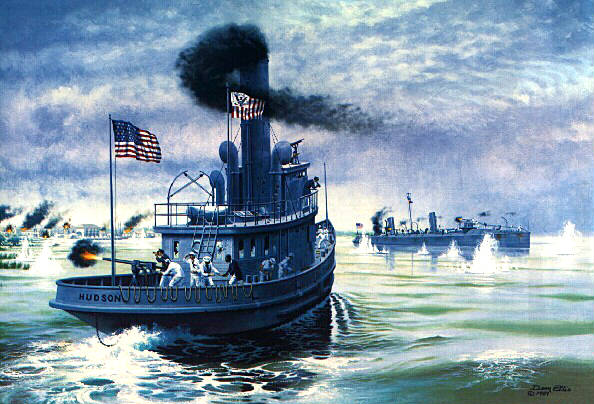|
U.S. Revenue Service, the Cutter Hudson |
|
|
Battle Of Cardenas Cuba - Spanish
American War |
|
|
|
|
 |
SIR: I have
the honor to submit the following report of the participation of this
vessel in the engagement with the Spanish forces at Cardenas on the 11th
instant:
At 11.30 a.m., while off the main entrance to Cardenas Bay, the Hudson was ordered by the senior officer present to accompany the U.S.S. Wilmington and the U.S. torpedo boat Winslow inside. All three vessels started immediately, and, after some preliminary soundings to determine the best water, passed through Blanco Channel into the bay and headed for Cardenas. About 1 p.m., when abreast of Corogal Point, the Hudson was ordered by the commanding officer of the U.S.S. Wilmington to "go out and look at small craft." Steamed over toward Diana Cay and skirted the western shore of the bay. Discovered no |
|
vessels, and
observing that the Wilmington and
Winslow were nearing
Cardenas, at 1.35 p.m. steamed toward them at full speed. At 1.45,
when a little over a mile distant from our vessels, saw firing commence
from the shore, which was immediately returned by our ships. At
1.50, when within range of the shore guns, the
Hudson opened fire
upon them with her two 6-pounders. Observing that the
Winslow
was quite inshore and exposed to the full strength of the enemy's guns,
ran up alongside of the Wilmington and asked if we should go to
her assistance (Winslow). Received the answer,
"Yes," and at once steamed into the immediate vicinity of the
Winslow,
keeping up a constant and rapid fire from the
Hudson's battery
upon the enemy's guns on shore. At 2.20, commanding officer of the
Winslow reported his vessel totally disabled, and requested to be
towed out of range. Owing to the shoal water and the rapid drift
toward shore of the Winslow (the wind was on shore), it was fully
thirty minutes before the Hudson succeeded in making a line fast
from the Winslow and started ahead with her. The enemy kept
up a constant fire during this time, which appeared to be especially
directed toward the Winslow, and which was returned at every
opportunity by the Winslow and
Hudson.
The
Winslow was towed
alongside the Wilmington, from which vessel a boat was sent with
a medical officer, who transferred the dead and wounded from the
Winslow
to the Wilmington. Finally, at about 3.30 p.m., all three
vessels steamed out of the bay, the Winslow in tow of the
Hudson.
At about dark joined the U.S.S. Machias outside where the
Winslow
was anchored. At 9.15 p.m., the Hudson started for Key West
with dispatches for the senior officer commanding that station, and
carrying the dead and wounded from the Winslow. Reported to
the senior officer commanding at Key West, at 7.10 on the morning of the
12th instant. The only damage resulting to the
Hudson
during the engagement was a few slight marks from small projectiles upon
two of the fire-room ventilators, and a few bullet marks upon the
outside of the pilot-house plating. One hundred and thirty-five
shells were fired from the two 6-pounders during the action. President William McKinley noted in his request to Congress to recognized the gallantry of Newcomb and his crew with a special medal. The President noted that "In the face of a most galling fire from the enemy's guns, the revenue cutter HUDSON, commanded by First Lieutenant Frank H. Newcomb, United States Revenue Cutter Service, rescued the disabled WINSLOW, her wounded commander and remaining crew. The commander of the HUDSON kept his vessel in the very hottest fire of the action, although in constant danger of going ashore on account of the shallow water, until he finally got a line fast to the WINSLOW and towed that vessel out of range of the enemy's guns, a deed of special gallantry." Congress awarded Newcomb a gold Congressional medal, the officers of Hudson received silver medals, and the crew received bronze medals for their heroism. These were the only specially struck medals awarded for bravery during the war. |
|
|
|
|